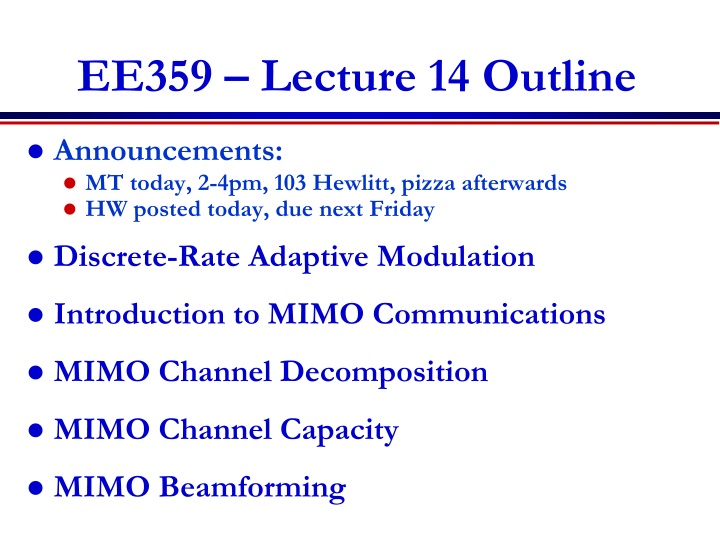
Adaptive Modulation, MIMO Communications, and Channel Capacity Overview
Dive into the world of adaptive modulation, MIMO communications, and channel capacity in this comprehensive lecture outline. Explore topics such as discrete-rate adaptive modulation, MIMO channel decomposition, MIMO beamforming, and more. Understand the principles behind optimal power and rate adaptation, constellation restrictions, power adaptation, average rate calculations, and practical considerations. Discover the efficiency in Rayleigh fading, spectral efficiency, and the intricacies of multiple input multiple output (MIMO) systems. Gain insights into designing and analyzing MIMO systems based on known channel information at the transmitter and receiver.
Download Presentation

Please find below an Image/Link to download the presentation.
The content on the website is provided AS IS for your information and personal use only. It may not be sold, licensed, or shared on other websites without obtaining consent from the author. If you encounter any issues during the download, it is possible that the publisher has removed the file from their server.
You are allowed to download the files provided on this website for personal or commercial use, subject to the condition that they are used lawfully. All files are the property of their respective owners.
The content on the website is provided AS IS for your information and personal use only. It may not be sold, licensed, or shared on other websites without obtaining consent from the author.
E N D
Presentation Transcript
EE359 Lecture 14 Outline Announcements: MT today, 2-4pm, 103 Hewlitt, pizza afterwards HW posted today, due next Friday Discrete-Rate Adaptive Modulation Introduction to MIMO Communications MIMO Channel Decomposition MIMO Channel Capacity MIMO Beamforming
Review of Last Lecture Introduction to adaptive modulation Vary different parameters of modulation relative to fading Variable-rate variable-power MQAM Maximize average throughput by changing rate and power Optimal power adaptation is water-filling 1 0 0 = ( P ) P 1 1 K 0 = K K 0 else 1 K Optimal rate adaptation: k log R B Equals capacity with effective power loss K=-1.5/ln(5BER). = ( ) . p d 2 K K
Review continued Constellation Restriction Restrict MD( ) to {M0=0, ,MN}. Let M( )= / *, where * is optimized for max rate Set MD( ) to maxj Mj: Mj M( ) (conservative) Region boundaries are j=Mj *, j=0, ,N Power control maintains target BER M3 M( )= / * M( )= / MD( ) M3 M2 M2 M1 M1 Outage 0 1=M1 K* 0 2 3
Power Adaptation and Average Rate Power adaptation: Fixed BER within each region Es/N0=(Mj-1)/K Channel inversion within a region Requires power increase when increasing M( ) = 0 P ( ) ( ) 1 /( ) , 0 P M K j + j 1 j j j 1 Average Rate N R = log ( ) M jp + 2 1 j j B = 1 j Practical Considerations (not covered in lecture): Cannot update more than every 10-100 symbols Estimation error/delay leads to irreducible error floor
Efficiency in Rayleigh Fading Spectral Efficiency (bps/Hz) Average SNR (dB)
Multiple Input Multiple Output (MIMO)Systems MIMO systems have multiple transmit and receiver antennas (Mt at TX, Mr at RX) x=[x1, ,xMt] y=[y1, ,yMr] TX power constraint: E[xxH]= =P/ 2 y=Hx+n Input described by vector x of dimension Mt Output described by vector y of dimension Mr Channel described by MrxMt matrix Design and capacity analysis depends on what is known about channel H at TX and RX If H unknown at TX, requires vector modulation/demod
MIMO Decomposition Decompose channel through transmit precoding (x=Vx) and receiver shaping (y=UHy) ~ ~ ~ ~ ~ y= x+n y=Hx+n H=U VH ~ ~ ~ yi= x+ni Leads to RH min(Mt,Mr) independent channels with gain i (ith singular value of H) and AWGN Independent channels lead to simple capacity analysis and modulation/demodulation design
MIMO Fading Channel Capacity If channel H known, waterfill over space (fixed power at each time instant) or space-time Without transmitter channel knowledge, capacity is based on an outage probability Pout is probability that channel capacity given the channel realization is below the transmission rate C Massive MIMO: random channel gains converge to static values: C = min(Mt,Mr) Blog(1+ ); is SNR
Main Points Discretizing the constellation size in adaptive MQMA results in negligible performance loss. Constellations cannot be updated faster than 10s to 100s of symbol times: OK for most dopplers. Estimation error/delay causes error floor MIMO systems exploit multiple antennas at both TX and RX for capacity and/or diversity gain With TX/RX CSI, decomposes into independent channels Capacity of MIMO systems Static channel with TX/RX CSI: sum of capacity on each spatial dimension Static channel without TX CSI: capacity metric is outage. Fading channel with TX/RX CSI: water-fill power over space or space-time to achieve capacity With only RX CSI, capacity metric is outage. Massive MIMO: C = min(Mt,Mr) Blog(1+ )
